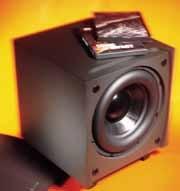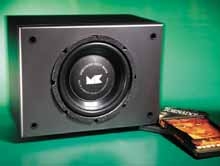Block Busters

While most subwoofers come in only one shape - the ubiquitous cube - they do come in a variety of sizes, and smaller subs are becoming more and more popular. Why? Because many of us have our home theaters in rooms that don't easily accommodate a big, black cube - thus the growing demand for smaller boxes that can still put out clean and copious deep bass.
Smaller subs have the same basic advantages as their bigger brethren. Most important, they can reproduce the rumbles and explosions on movie soundtracks that most satellite speakers can't handle. Also, using a standalone sub greatly increases your speaker-placement options. Splitting off the deep bass and sending it to a subwoofer lets you place the main-channel speakers where they'll sound best without having to worry about their bass performance.
Now that I've sung the praises of smaller subs, let's take a look at five of them: Cambridge SoundWorks' Newton P200 ($600), JBL's HTPS-400 ($2,000), M&K's K-10 ($599), PSB's SubZeroi ($299), and Velodyne's SPL-1000 ($1,499).
Jump ahead: Complete article including Fast Facts and In the Lab
All but one have a footprint of around a square foot and a gross volume of about a cubic foot - the JBL takes up a still unobtrusive 1 1/2 square feet of floor space and has a volume just under 2 cubic feet. All but the ported PSB have sealed enclosures. All but the JBL provide both line- and speaker-level inputs (the JBL has just a line-level input). And all but the M&K have circuits that keep the sub on standby power until a signal appears at its inputs.
But for everything they have in common, these subs differ in a couple of respects. Their amp ratings vary considerably, and each rests on its own rung of the price ladder. But our mission here is to compare subs of similar size - not power or price.
To see how they fared, I set each sub up in the optimal corner of my large, 7,500-cubic-foot room with my reference speaker system. In every case, after experimenting with crossover settings, I ended up with an optimal setting of around 80 Hz - though the actual setting varied considerably from the marked setting on all five subs. I listened to the same familiar CD and DVD tracks in each case (see "Tom's Top 10 Torture Tracks" on page 102) as well as other recordings with deep-bass content.
After listening, I measured each sub following my usual procedures (see "In the Lab," page 104), with one notable addition. I generated a figure that doesn't normally appear in our lab tests: "usable bass." First, I balanced each subwoofer with my stereo pair of powered speakers and played "976-BASS" from Bass Erotica's Bass Ecstasy, a track that has very strong energy in the lower bass range combined with midrange vocals. Then I slowly turned up the volume until either the subwoofer audibly protested or there was an obvious shift in overall tonal balance, which occurs when the sub can't "keep up" with the main speakers.
I call the peak SPL reading over the first 60 seconds of this test track the sub's usable bass. Because the test is so dependent on the particular speaker system, my particular room, and this particular recording, the usable-bass figures can't be taken as absolutes, but they do give a relative ranking of dynamic performance.
PSB SubZeroi
The most wallet-friendly sub in this batch, the SubZeroi breaks out of the typical cube to assume more speaker-like proportions. The front-mounted level and crossover controls are useful if you like to tailor the sound for each movie or if you just don't want to have to move the sub out of position to make adjustments. And a toggle switch lets you bypass the crossover if you'd rather handle that function through your preamp or receiver. I had little trouble integrating the PSB sub with my satellite speakers.
At normal listening levels, the PSB sub got the tonal balance just about right, helping to keep the vocals and instruments clearly placed and stable. But it did occasionally swallow a lower bass note in "You're Sensational," from the Mary Stallings Live at the Village Vanguard CD. And the sound lacked the nth degree of punch on "The Higher You Rise," from Sheffield Labs' The Drum and Track Disc, as well as a full sense of envelopment on "Places You Find Love" from Quincy Jones's Back on the Block. The SubZeroi never infected any vocalist's chops, however, or interfered with acoustic instruments working above the bass range.
In general, the PSB offers better-than-average output for its price class. But as the reference material got more challenging and the sound-pressure level (SPL) passed 90 dB on the meter, the tonal balance shifted upward significantly, emphasizing the upper-bass registers. There was no "chuffing," however, or any of the other overload annoyances that are sometimes heard with ported speakers.
The SubZeroi managed to make it down to a convincing 32 Hz - which is probably low enough for modest home theater setups. You can't help but admire a product that knows its limits and faithfully observes them.
M&K K-10
In general, the M&K K-10 is a reasonably well-equipped sub, lacking only a power switch and pass-through speaker-level outputs for hooking up your front left/ right speakers. Since the sub is always on when it's plugged in, you'll want to connect it to a switched outlet on your receiver - just make sure it's rated to supply 200 watts.
 | |
With jazz and softer rock, the M&K did a good job of anchoring the soundstage, helping to keep voices and instruments in their proper places. Full, well-rounded bass can help to increase the sense of spaciousness, but the K-10's contribution was occasionally anemic, compressing the soundstage from front to back.
As an interesting wrinkle, I also tested the K-10 stacked with M&K's K-11 sub - which is identical to the K-10 in price and in almost every other way except that its driver is mounted with the magnet sticking out of the cabinet (see photo below) and wired with opposite polarity. Combined, the K-10 and K-11 operate in "push-pull" fashion, where one sub's driver pushes out while the other's pulls in. This is said to both improve the sound quality and increase total output.
Measured alone, the K-11 had slightly less output than the K-10 and a marginally different response curve, but these differences are probably due either to the change in the K-11's internal cabinet volume caused by the inverted driver or, more likely, to the normal manufacturing variations between two samples of the same speaker. When the two subs were placed next to each other or stacked, the SPL measured from the pair was 5 dB higher than from one alone. But I wasn't able to detect any improvement in sound quality that couldn't be attributed to that increase in dynamic capability. Did the push-pull woofer alignment make the K-10/K-11 combo work significantly better than simply using two K-10s together? I'm not convinced, but the stacked arrangement did produce a more spacious, enveloping sound than the single sub.
Cambridge SoundWorks Newton P200
The Newton Series P200's trim, tall profile keeps its floor-space requirements down to just over a square foot. Like the M&K, the P200 gives you the basic input options but fails to provide any pass-through outputs. All the operating controls are on a small panel at the rear of the sub, which can be hard to reach for on-the-fly adjustments. The sub's 10-inch driver sports the kind of wide (1 1/2-inch) surround used in car woofers. This wider surround is supposed to allow the cone to move farther forward and back than usual, thus moving more air and producing louder bass.
 | |
Velodyne SPL-1000
Velodyne has long been considered a leader in subwoofer design. And the SPL-1000's styling and finish suggest that the company hasn't had any trouble moving into the 21st century. The sub has a full set of features, including pass-through line- and speaker-level outputs and magnetic shielding, which allows you to place it close to your TV without screwing up the picture.
 | |
The kick drum on The Drum and Track Disc delivered a powerful blow to my chest. Being able to feel as well as hear the first, distant dinosaur step on "Jurassic Lunch" from The Great Fantasy and Adventure Album helped to create an impressive sense of spaciousness and envelopment. Even the relatively modest demands of Ray Brown's acoustic bass on Oscar Peterson's "You Look Good to Me" showed off the Velodyne sub's ability to convey detail as well as a realistic sense of soundstage depth.
Able to go down to 25 Hz and hit a respectable 91-dB SPL, the SPL-1000 did its part to maintain Velodyne's reputation. The less expensive subs here will give you decent enough middle and upper bass, but the SPL-1000 will take you most of the way to real deep bass.
JBL HTPS-400
With the biggest driver, most power, biggest footprint, and biggest cabinet, the THX-certified JBL HTPS-400 is better equipped than any other sub here to plumb the sonic depths. (Of course, it's also $500 more than the next most expensive sub.) But size doesn't always (or even often) equal subtlety, so the JBL also had to prove that it could sound musical.
 | |
The JBL HTPS-400's solid performance at 25 Hz showed that it's every inch a true subwoofer. It certainly made its imposing presence felt among the smaller entries in this comparison.
When Small Is Big
What can we learn from this exercise? For all of the advantages of small enclosures, the bigger the subwoofer - in size, power, weight, and price - the better it's likely to perform. So it's not too surprising that the $2,000 JBL proved to be the best subwoofer of the lot, with the $1,499 Velodyne not far behind. The $600 Cambridge SoundWorks, $299 PSB, and $599 M&K entries might be better termed bass modules than subwoofers since they can't play Herculean program material at true subwoofer levels like the Velodyne and JBL can. But that doesn't mean they can't significantly improve the overall sound of your system. They're best suited for small rooms or for systems that are geared toward less demanding music recordings and movie soundtracks.
If you're looking to keep things small, the M&K K-10 has just a tad less gross
 | |
| One of Tom's favorite torture tracks, Chapter 18 of End of Days produces plenty of low-end subwoofer rumble. |
No, your sub doesn't have to overwhelm your room, visually or sonically, to get the job done. Any one of the models reviewed here will help you strike an appropriate balance among price, size, and performance. So you don't have to be seduced by those hulking bass monsters on display in the audio dealer's showroom. Sometimes the best way to get something big is to think small.
- Log in or register to post comments




















































